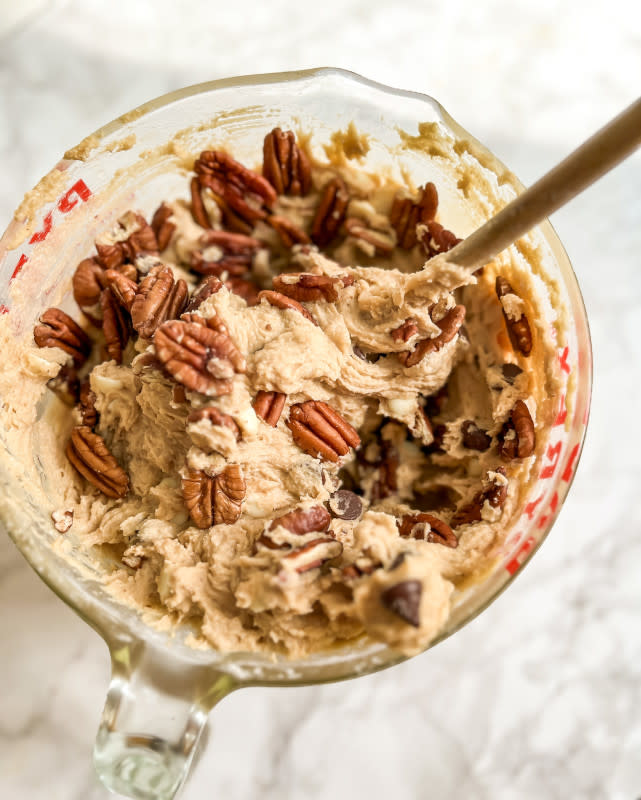The Secret to Soft, Chewy, Never-Dry Chocolate Chip Cookies

If you’re an avid baker like me, you may have also been waiting (not so) patiently this past December for King Arthur Baking to roll out their “2024 Recipe of the Year.” This year that honor was bestowed upon their Supersized, Super-Soft Chocolate Chip Cookies.
Chocolate chip cookies are a baked good I know and love, but when I read through the King Arthur recipe I was surprised to see that it included tangzhong, a technique most often seen in bread-making. After making the recipe twice now, I can honestly say I’ve never made a cookie that holds up as well and continues to stay soft over the course of a few days like these—and it’s all thanks to the tangzhong method. Here's what you need to know to make these next-level treats at home.
Related: I Got a Sneak Peek of King Arthur’s 2024 Recipe of the Year—Here’s Why It’s 100% Worth Making
What is the Tangzhong Method?
Most often used in bread-making, the tangzhong method is a technique in which a small portion of the flour in a recipe is combined with a liquid (usually either milk and/or water) and cooked until the starch in the flour gelatinizes and forms a paste (this typically happens once it reaches about 150°F). This paste, sometimes referred to as “water roux,” is then added to the dough or batter.
Tangzhong (the Chinese name for this technique) is often credited as being popularized by Taiwanese chef and cookbook author Yvonne Chen through her cookbook, 65ºC Bread Doctor. While Chen’s popularization of the technique is fairly agreed upon, tangzhong’s exact origins remain blurry. Many believe that it came from the Japanese yudane method. Whereas tangzhong calls for cooking the flour mixture, the yudane method calls for pouring boiling water over a portion of the flour (usually a 1:1 ratio) and stirring it together to form a paste.
Related: The Secret Ingredient to the Best-Ever Sugar Cookies
What Does the Tangzhong Method Do for Baked Goods?
Most relevant to soft and/or enriched bread recipes, gelatinizing the flour allows the dough to take on more water. This is especially helpful when used in bread as it lets you increase the hydration of the dough while keeping the dough manageable (read: not overly sticky and slack). Higher hydration translates to softer, plusher breads (the ones that you see everyone squishing on social media). Using tangzhong can also allow you to use a moderate hydration level and still create a soft bread because the baked goods gain moisture from the tangzhong paste.
Related: 50 Easy Savory Bread Recipes

Courtesy of Jessica Wrubel
What Does the Tangzhong Method Do for Chocolate Chip Cookies?
We all know the scene: after a few days, most cookies turn crumbly or dry (or worse, both!), no matter how you store them. But using the tangzhong method lets the dough to take on more water and the higher hydration has some pretty magical effects.
Cookies made with tangzhong are chewy right off the bat but they become soft in the first day after baking and continue to stay that way for several days. When the starches in the cooked flour mixture gelatinize, they trap the free water from the liquid that was added to the mixture, and that moisture remains in the dough well past baking. What does that all really mean? No more stale cookies!
Other Ways to Use the Tangzhong Method
Tangzhong is the most beneficial in baked goods, both sweet and savory. You’ll most often come across the tangzhong method in bread recipes where the end result is a soft, tender bread rather than a crustier, lean dough, such as sourdough or baguettes. But tangzhong is worth incorporating into a number of baked goods beyond bread, as evidenced by King Arthur Baking chocolate chip cookies.
Recipes you may have seen this technique used include Eric Kim’s Maple Milk Bread, King Arthur’s wildly popular Perfectly Pillowy Cinnamon Rolls and Claire Saffitz’s Pull-Apart Sour Cream and Chive Rolls, but you may have also come across it (or yudane) in bakery or store-bought bread, such as shokupan, without even realizing it.
Tips and Tricks for Using the Tangzhong Method
Keep an eye on things. You’ll be able to visually see the flour and liquid mixture thicken and transform into a paste, at which point you should reference your recipe for the visual cue they give. If your mixture is moving slowly and/or you’re unsure if you took it far enough, use a thermometer to check the temperature. You’re looking for about 150°F.
Take your time. Tangzhong is usually made at home in smaller, controlled amounts, so the thickening process happens quickly. Follow what your recipe calls for. If you’re nervous, be more moderate and cook lower so you have more control.
Keep the mixture constantly moving. I like to whisk mine continuously as it's cooking to make sure it doesn't stick to the saucepan and burn and to ensure all the flour gets incorporated.
Avoid overcooking. You want to cook tangzhong so it forms a paste, but if you take it too far you'll lose the moisture you’re trying to retain.
Watch the temperature. If following a specific recipe, use the tangzhong at the temperature instructed. If tweaking a bread recipe to utilize tangzhong, allow the paste to cool completely.
Up next: The Secret Ingredient for Extra Chewy Rice Krispies Treats That Stay Soft for Days

